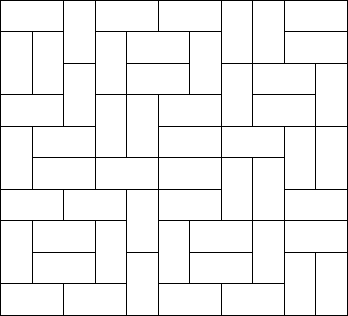Mondriaan's Dream
| Time Limit: 3000MS | Memory Limit: 65536K | |
| Total Submissions: 15295 | Accepted: 8820 |
Description
Squares and rectangles fascinated the famous Dutch painter Piet Mondriaan. One night, after producing the drawings in his 'toilet series' (where he had to use his toilet paper to draw on, for all of his paper was filled with squares and rectangles), he dreamt of filling a large rectangle with small rectangles of width 2 and height 1 in varying ways.

Expert as he was in this material, he saw at a glance that he'll need a computer to calculate the number of ways to fill the large rectangle whose dimensions were integer values, as well. Help him, so that his dream won't turn into a nightmare!

Expert as he was in this material, he saw at a glance that he'll need a computer to calculate the number of ways to fill the large rectangle whose dimensions were integer values, as well. Help him, so that his dream won't turn into a nightmare!
Input
The input contains several test cases. Each test case is made up of two integer numbers: the height h and the width w of the large rectangle. Input is terminated by h=w=0. Otherwise, 1<=h,w<=11.
Output
 For each test case, output the number of different ways the given rectangle can be filled with small rectangles of size 2 times 1. Assume the given large rectangle is oriented, i.e. count symmetrical tilings multiple times.
For each test case, output the number of different ways the given rectangle can be filled with small rectangles of size 2 times 1. Assume the given large rectangle is oriented, i.e. count symmetrical tilings multiple times. Sample Input
1 2 1 3 1 4 2 2 2 3 2 4 2 11 4 11 0 0
Sample Output
1 0 1 2 3 5 144 51205
Source
/* 已经给了时间看题解了,正式练习一道题三天之内不准再看题解! */ #include <iostream> #include <stdio.h> #include <string.h> #define N (1<<12)+5 #define M 12 /* 用1表示当前小方格填满了,0表示没填满,初始化第一行的状态然后递推到最后一行 */ using namespace std; long long dp[M][N];//dp[i][j]表示第i行j种状态做多有多少种排列方式 int n,m; bool check(int x)//判断是不是有连续个奇数个1;当有连续奇数个1的时候那么这一行横着放的肯定是不会填满的 { int s=0; while(x) { if(x&1)s++; else { if(s&1)return false; s=0; } x>>=1; } if(s&1)return false; return true; } int main() { ///for(int i=0;i<30;i++) // cout<<"i="<<i<<" "<<check(i)<<endl; //cout<<endl; //freopen("in.txt","r",stdin); //freopen("out.txt","w",stdout); while(scanf("%d%d",&n,&m)!=EOF&&n&&m) { if((n*m)%2)//如果乘积是奇数的话是肯定铺不满的 { printf("0 "); continue; } if(n<m)//这里做一个剪枝,使m永远是小的那个,能减少不少循环的次数 { int tmp=n; n=m; m=tmp; } int tol=(1<<m); memset(dp,0,sizeof dp); for(int i=0;i<tol;i++)//初始第一行的状态 if(check(i)) dp[1][i]=1; for(int i=1;i<n;i++)//由i行推出i+1行 for(int j=0;j<tol;j++)//枚举上一个状态 if(dp[i][j]!=0)//上一个状态为零没计算意义 { for(int k=0;k<tol;k++) { if( (j|k)==tol-1 && check(j&k) )//这一步很精妙,(j|k)==tol-1保证了肯定能填满上一行,check(j&k)保证了这一行中横着放的小木块绝对能填满 dp[i+1][k]+=dp[i][j]; } } printf("%lld ",dp[n][tol-1]); } return 0; }